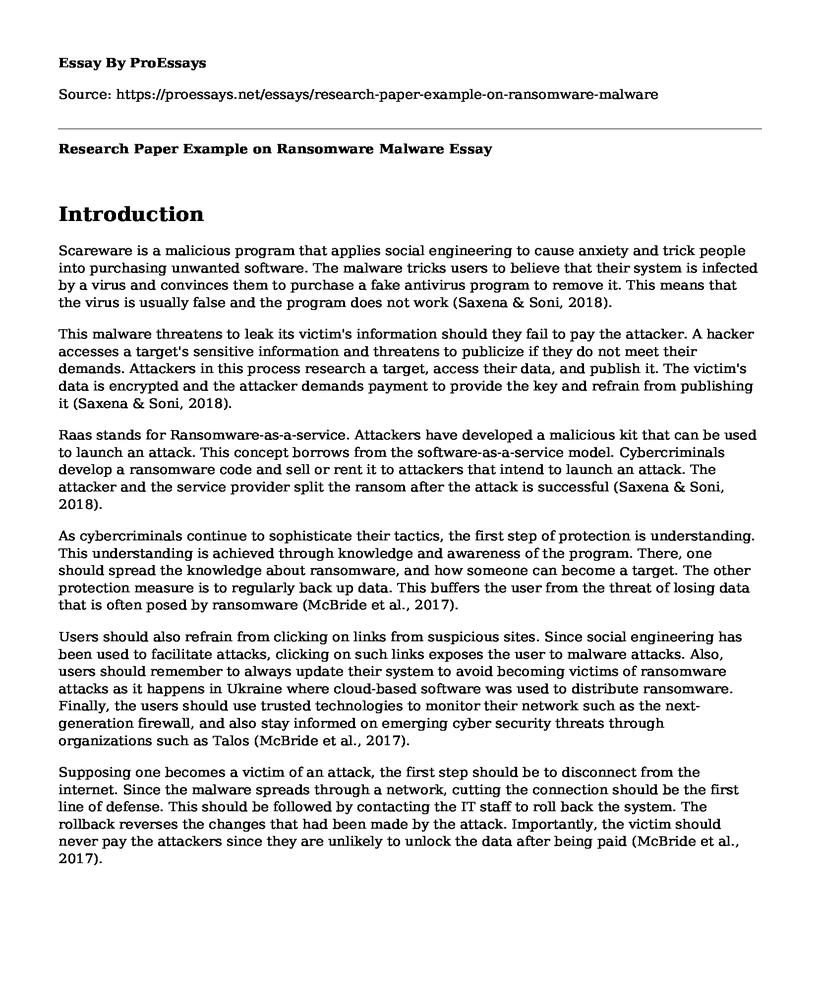Introduction
Scareware is a malicious program that applies social engineering to cause anxiety and trick people into purchasing unwanted software. The malware tricks users to believe that their system is infected by a virus and convinces them to purchase a fake antivirus program to remove it. This means that the virus is usually false and the program does not work (Saxena & Soni, 2018).
This malware threatens to leak its victim's information should they fail to pay the attacker. A hacker accesses a target's sensitive information and threatens to publicize if they do not meet their demands. Attackers in this process research a target, access their data, and publish it. The victim's data is encrypted and the attacker demands payment to provide the key and refrain from publishing it (Saxena & Soni, 2018).
Raas stands for Ransomware-as-a-service. Attackers have developed a malicious kit that can be used to launch an attack. This concept borrows from the software-as-a-service model. Cybercriminals develop a ransomware code and sell or rent it to attackers that intend to launch an attack. The attacker and the service provider split the ransom after the attack is successful (Saxena & Soni, 2018).
As cybercriminals continue to sophisticate their tactics, the first step of protection is understanding. This understanding is achieved through knowledge and awareness of the program. There, one should spread the knowledge about ransomware, and how someone can become a target. The other protection measure is to regularly back up data. This buffers the user from the threat of losing data that is often posed by ransomware (McBride et al., 2017).
Users should also refrain from clicking on links from suspicious sites. Since social engineering has been used to facilitate attacks, clicking on such links exposes the user to malware attacks. Also, users should remember to always update their system to avoid becoming victims of ransomware attacks as it happens in Ukraine where cloud-based software was used to distribute ransomware. Finally, the users should use trusted technologies to monitor their network such as the next-generation firewall, and also stay informed on emerging cyber security threats through organizations such as Talos (McBride et al., 2017).
Supposing one becomes a victim of an attack, the first step should be to disconnect from the internet. Since the malware spreads through a network, cutting the connection should be the first line of defense. This should be followed by contacting the IT staff to roll back the system. The rollback reverses the changes that had been made by the attack. Importantly, the victim should never pay the attackers since they are unlikely to unlock the data after being paid (McBride et al., 2017).
Conclusion
In conclusion, ransomware malware operates by restricting system access. The restriction lasts until the victim meets the demands made by the attacker. There are several variants of ransomware that coerce users to comply with the demands of cybercriminals. Users should stay informed on emerging trends in cybersecurity to ensure the protection of their systems. This together with the existing prevention, detection, and recovery systems help to constantly ensure data safety
References
Ferreira, A. (2018). Why Ransomware Needs A Human Touch. 2018 International Carnahan Conference On Security Technology (ICCST). doi: 10.1109/ccst.2018.8585650
McBride, T., Ekstrom, M., Lusty, L., Sexton, J., & Townsend, A. (2017, September 1). Data Integrity: Recovering from Ransomware and Other Destructive Events. Retrieved from NIST: https://www.nccoe.nist.gov/projects/building-blocks/data-integrity/recover
Saxena, S., & Soni, H. (2018). Strategies for Ransomware Removal and Prevention. 2018 Fourth International Conference On Advances In Electrical, Electronics, Information, Communication, And Bio-Informatics (AEEICB). doi: 10.1109/aeeicb.2018.8480941
Cite this page
Research Paper Example on Ransomware Malware. (2022, Mar 08). Retrieved from https://proessays.net/essays/research-paper-example-on-ransomware-malware
If you are the original author of this essay and no longer wish to have it published on the ProEssays website, please click below to request its removal:
- Teens and the Internet: Annotated Bibliography
- Personal Statement for My Innovative Techniques
- SAP Evaluation and Data Management Paper Example
- Essay Sample on Challenges of Network-Based Research
- Modern Technology and Social Change Essay
- Data Visualization: Connecting Audiences to Data - Essay Sample
- Organization Security: Protecting Database from Risks - Essay Sample







